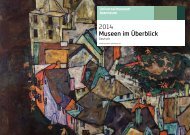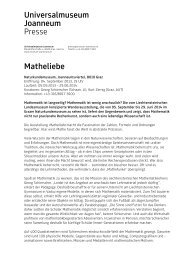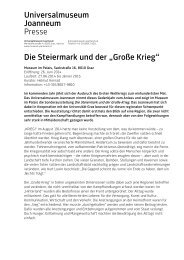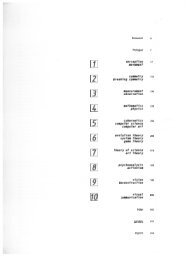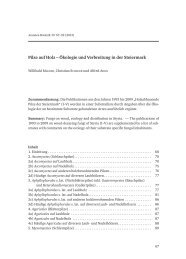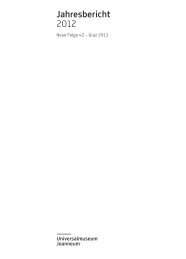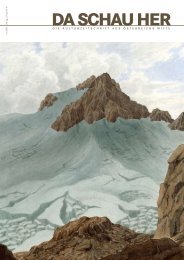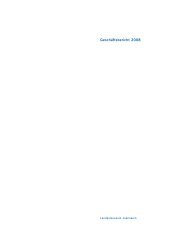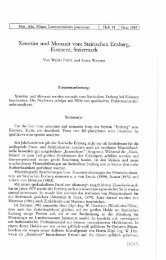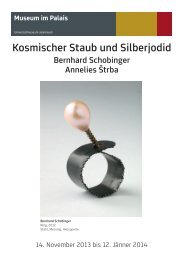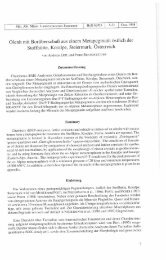Diana Thater gorillagorillagorilla - Universalmuseum Joanneum
Diana Thater gorillagorillagorilla - Universalmuseum Joanneum
Diana Thater gorillagorillagorilla - Universalmuseum Joanneum
Sie wollen auch ein ePaper? Erhöhen Sie die Reichweite Ihrer Titel.
YUMPU macht aus Druck-PDFs automatisch weboptimierte ePaper, die Google liebt.
von Verzeichnissen angefangen, als ich anfing, künstlerisch aktiv<br />
zu werden. Zu dieser Zeit habe ich auch begonnen, theoretische<br />
und philosophische Texte zu lesen. Als passionierte Romanleserin<br />
fand ich diese Gattungen schwer verständlich, wenn ich sie<br />
von vorne nach hinten las. Also habe ich sie in einer völlig willkürlichen<br />
Reihenfolge gelesen, indem ich das Stichwortverzeichnis<br />
als Inhaltsverzeichnis verwendete. Als ich herausfand, dass das<br />
Stichwortverzeichnis seine eigene Logik hat und eine Art fettgedruckte<br />
Überlagerung auf diesem sehr komplexen Text bildet,<br />
versuchte ich selber ein paar davon in Form von Kunstwerken<br />
zu machen und schrieb letztendlich sogar Stichwortverzeichnisse<br />
für ein paar Kunstgeschichte- und Theoriebände. Wirklich,<br />
Text arbeiten befriedigen meine Sehnsucht nach Wortbildern,<br />
die wie Lyrik funktionieren, indem sie rhythmisch sind und etwas<br />
heraufbeschwören, ohne beschreibend oder erzählend zu sein.<br />
Doch sie implizieren, sie evozieren die Eigenschaft der Narrativität,<br />
die in zeitbasierten Medien immer zum Ausdruck kommt<br />
oder verdrängt wird und angesprochen werden muss.“19<br />
Eine solche indizierte Erzählung als Instrument der Strukturierung<br />
der Grammatik lässt die Interpretations- und Betrachtungsmöglichkeiten<br />
wuchern und vervielfältigt die Wahlmöglichkeiten;<br />
sie „holt einen aus einem einzigen Blickwinkel heraus und<br />
ermöglicht eine Form von Polyphonie – eine Gruppe von Dingen,<br />
die scheinbar alle gleichzeitig existieren –, weil das Stichwortverzeichnis<br />
eine komprimierte und in eine neue Reihenfolge<br />
gebrachte Version des Buches ist und man sich nicht sicher ist, wo<br />
die Verweise in der Chronologie des eigentlichen Texts auftauchen<br />
werden. Die Echtzeit des Texts ist ausgelöscht“20. <strong>Diana</strong> <strong>Thater</strong>s<br />
Stichwortverzeichnis für ihre Installation <strong>gorillagorillagorilla</strong> mit<br />
dem Titel „Dies sind ihre Namen“, die sich alphabetisch von<br />
„animal“ bis „zoopoetics“ erstreckt, ist eine ganz besondere<br />
Sammlung von Quasi-Wörterbucheinträgen, die das konzeptuelle<br />
Skelett ihrer neuen Arbeit ausmachen. An einen Bewusstseinsstrom<br />
als ein ganz besonderes freies Editierverfahren erinnernd<br />
und kombiniert mit Bildern, fungiert das Stichwortverzeichnis<br />
als ein Aufsatz, in dem die Künstlerin ihr Vokabular „benennt“<br />
(die wichtigsten Themen, mit denen sich das Werk befasst, sowie<br />
Verweise, Pseudo-Credits, aber auch einige Nuancen von Konzepten,<br />
interpretatorischen Zweifeln und subtilen Lesevorschlägen)<br />
und den Protagonisten ihres rhythmisch mit <strong>gorillagorillagorilla</strong><br />
betitelten Werks Tribut zollt. Die wirklichen Namen der Gorillas,<br />
mit denen <strong>Diana</strong> <strong>Thater</strong> in Kamerun gearbeitet hat und die sie<br />
gefilmt hat – Avishag, Bobo, Djanga, Eto’o und viele andere –,<br />
interpunktieren und dynamisieren die Erzählung des Stichwortverzeichnisses,<br />
das in der Tat die Rolle einer strukturellen Fußnote<br />
Adam Budak 18 19<br />
becomes visible and nouns stand out like proper<br />
names. I began writing indices when I began making<br />
art, which was also the time when I started reading<br />
theory and philosophy. Being a dedicated reader<br />
of fiction, I found those forms difficult to understand<br />
sequentially so I would read them randomly using the<br />
index as a table of contents. When I realized that the<br />
index has its own logic and forms a kind of bold-faced<br />
overlay on top of this very complex text, I tried to<br />
write some for myself as artworks, and also ended up<br />
writing indices for a few art history and theory books.<br />
Really, making text works satisfies my desire to have<br />
word images that function like poetry in that they<br />
are rhythmic and evocative without being descriptive<br />
and narrative. However they imply, they evoke the<br />
state of narrativity, which is always being expressed,<br />
or repressed in time-based media and must be<br />
addressed.”19<br />
Such an indexed narrative as a device for structuring<br />
grammar proliferates the reading and viewing possibilities<br />
and multiplies choice options; it “removes<br />
one from a single point of view and allows for a kind<br />
of polyphony – a group of things that seem to exist<br />
all at once – because the index is a compressed<br />
re-sequenced version of the book and one is not sure<br />
where in the time of the actual text the references will<br />
appear. The real time of the text is effaced”20. <strong>Thater</strong>’s<br />
index for her installation <strong>gorillagorillagorilla</strong>, entitled<br />
“These Are Their Names”, spread alphabetically from<br />
“animal” down to “zoopoetics” is a particular collection,<br />
as if dictionary’s entries that constitute the conceptual<br />
skeleton of her new work. Reminiscent of a stream of<br />
consciousness, as a particular free mode of editing,<br />
and combined with images, the index functions as an<br />
essay where the artist “names” her vocabulary (the<br />
most crucial issues the work is concerned with as well<br />
as references, as if credit lines, but also some nuances<br />
of concepts, interpretative doubts, and subtle reading<br />
suggestions) and pays a tribute to the main heroes<br />
of her rhythmically titled work, <strong>gorillagorillagorilla</strong>. The<br />
actual names of the gorillas <strong>Thater</strong> worked with and<br />
filmed in Cameroon, Avishag, Bobo, Djanga, Eto’o, and<br />
many others, punctuate and dynamize the index’s<br />
narrative which in fact takes on the role of a structural<br />
footnote to the major visual layer of the installation



